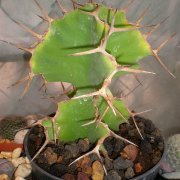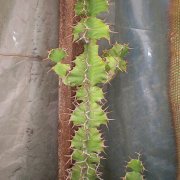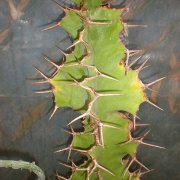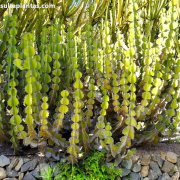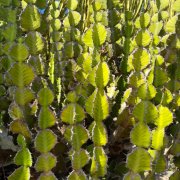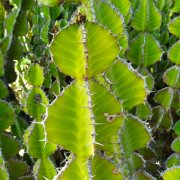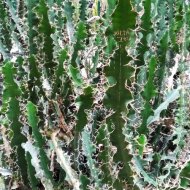Care of the succulent plant Euphorbia grandicornis or Cow's Horn |
|
The genus Euphorbia, family Euphorbiaceae, includes 2,000 species of succulents, trees, shrubs, and herbaceous plants of cosmopolitan distribution. Some species are: Euphorbia grandicornis, Euphorbia viguieri, Euphorbia meloformis, Euphorbia lomelii, Euphorbia flanaganii, Euphorbia enterophora, Euphorbia enopla, Euphorbia echinus, Euphorbia cotinifolia, Euphorbia coerulescens, Euphorbia characias, Euphorbia candelabrum, Euphorbia canariensis, Euphorbia pulcherrima, Euphorbia resinifera, Euphorbia milii, Euphorbia tithymaloides, Euphorbia regis-jubae, Euphorbia royleana, Euphorbia bubalina, Euphorbia trigona, Euphorbia bivonae, Euphorbia rigida, Euphorbia handiensis, Euphorbia balsamifera, Euphorbia leucocephala. Common names: Cow's Horn, Zig Zag Cactus, Rhino Thorn, Big Horn, Big Horned Spurge. This species is native to South Africa, Swaziland, Mozambique and Kenya. They are succulent plants with a bushy bearing with a short main stem that branches and reaches 2 meters (6.56 feet) in height. They have segments separated by constrictions and 3 marked and wavy edges whose horny edge has pairs of spines of 7 cm (2.75")and light brown or gray color. They produce small yellow flowers typical of Euphorbias. They bloom in spring. The fruits are reddish and are very decorative. Euphorbia grandicornis is used in cactus and succulent gardens, in rockeries, on sunny slopes, in pots for patios and terraces, and as indoor plants. They are slow-growing plants that prefer full sun exposure when they are adults and in semi-shade when they are young. Cow's Horn resists well the intense heat of the Mediterranean summer; in winter the temperature should not be lower than 5 ºC (41 ºF). The soil can be a mixture, in the same proportions, of coarse sand, leaf mulch and garden substrate. The transplant is done in early spring. Water moderately waiting for the substrate to be well dry. In winter do not water. Fertilize with compost in early spring. Zig Zag Cactus does not need pruning. The only danger for these plants is excess moisture that can rot the tissues. Big Horned Spurge propagates by seeds sown in a sandy substrate or by segment cuttings; Protect yourself from irritating latex and allow the cutting to dry before rooting. |
Images of the succulent plant Euphorbia grandicornis or Cow's Horn |
Find plants
Euphorbia grandicornis or Cow's Horn | Care and Growing
© 2025 FavThemes
